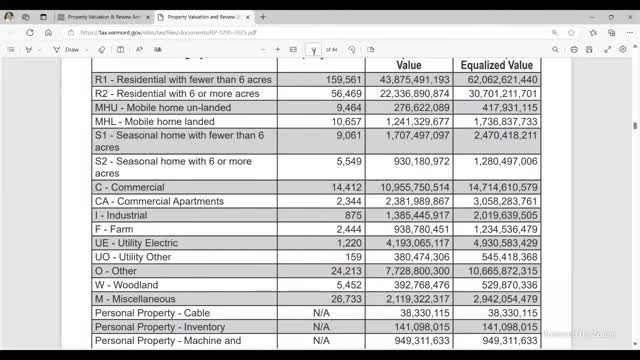Statewide property values surge 14 percent as equalization study reveals significant growth trends
January 24, 2025 | Ways & Means, HOUSE OF REPRESENTATIVES, Committees, Legislative , Vermont
This article was created by AI summarizing key points discussed. AI makes mistakes, so for full details and context, please refer to the video of the full meeting. Please report any errors so we can fix them. Report an error »

The House Ways and Means Committee in Vermont convened on January 24, 2025, to discuss the findings of the recent equalization study, which plays a crucial role in property valuation and taxation across the state. The meeting highlighted significant variations in how different towns classify property types, which can impact the accuracy of property assessments.
During the session, committee members reviewed a comprehensive breakdown of the equalization study, emphasizing the importance of consistent data input from various towns. It was noted that discrepancies in classification—such as how condominiums and farms are categorized—could lead to inconsistencies in property valuations. The committee expressed a desire to reduce these variations to improve the overall assessment process.
The discussion also revealed that the listed value of properties in Vermont has seen a notable increase. The value of properties rose by 7.8% due to new constructions and reappraisals, while the equalized education property value surged by 14.1%. This marks a significant shift from previous years, where annual increases were typically around 3%. The committee acknowledged that this trend of double-digit growth in property values has persisted for two consecutive years, a notable change from the more modest increases seen in the past.
The meeting further addressed the implications of these findings for municipal grants and tax rates. The statewide Common Level of Appraisal (CLA) has decreased, indicating that property values are currently assessed at approximately 72.36% of their fair market value. This decline in CLA could affect tax rates and the distribution of municipal funding.
As the committee concluded its discussions, it underscored the importance of the equalization study in providing a clearer picture of property values across Vermont, which is essential for fair taxation and resource allocation. The findings will inform future policy decisions and adjustments in property assessment practices.
During the session, committee members reviewed a comprehensive breakdown of the equalization study, emphasizing the importance of consistent data input from various towns. It was noted that discrepancies in classification—such as how condominiums and farms are categorized—could lead to inconsistencies in property valuations. The committee expressed a desire to reduce these variations to improve the overall assessment process.
The discussion also revealed that the listed value of properties in Vermont has seen a notable increase. The value of properties rose by 7.8% due to new constructions and reappraisals, while the equalized education property value surged by 14.1%. This marks a significant shift from previous years, where annual increases were typically around 3%. The committee acknowledged that this trend of double-digit growth in property values has persisted for two consecutive years, a notable change from the more modest increases seen in the past.
The meeting further addressed the implications of these findings for municipal grants and tax rates. The statewide Common Level of Appraisal (CLA) has decreased, indicating that property values are currently assessed at approximately 72.36% of their fair market value. This decline in CLA could affect tax rates and the distribution of municipal funding.
As the committee concluded its discussions, it underscored the importance of the equalization study in providing a clearer picture of property values across Vermont, which is essential for fair taxation and resource allocation. The findings will inform future policy decisions and adjustments in property assessment practices.
View full meeting
This article is based on a recent meeting—watch the full video and explore the complete transcript for deeper insights into the discussion.
View full meeting